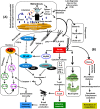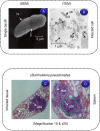Melioidosis: Clinical impact and public health threat in the tropics
- PMID: 28493905
- PMCID: PMC5426594
- DOI: 10.1371/journal.pntd.0004738
Melioidosis: Clinical impact and public health threat in the tropics
Retraction in
-
Retraction: Melioidosis: Clinical impact and public health threat in the tropics.PLoS Negl Trop Dis. 2020 Jul 1;14(7):e0008441. doi: 10.1371/journal.pntd.0008441. eCollection 2020 Jul. PLoS Negl Trop Dis. 2020. PMID: 32609720 Free PMC article. No abstract available.
Abstract
This review briefly summarizes the geographical distribution and clinical impact of melioidosis, especially in the tropics. Burkholderia pseudomallei (a gram-negative bacterium) is the major causative agent for melioidosis, which is prevalent in Singapore, Malaysia, Thailand, Vietnam, and Northern Australia. Melioidosis patients are increasingly being recognized in other parts of the world. The bacteria are intrinsically resistant to many antimicrobial agents, but prolonged treatment, especially with combinations of antibiotics, may be effective. Despite therapy, the overall case fatality rate of septicemia in melioidosis remains significantly high. Intracellular survival of the bacteria within macrophages may progress to chronic infections, and about 10% of patients suffer relapses. In the coming decades, melioidosis will increasingly afflict travelers throughout many global regions. Clinicians managing travelers returning from the subtropics or tropics with severe pneumonia or septicemia should consider acute melioidosis as a differential diagnosis. Patients with open skin wounds, diabetes, or chronic renal disease are at higher risk for melioidosis and should avoid direct contact with soil and standing water in endemic regions. Furthermore, there are fears that B. pseudomallei may be used as a biological weapon. Technological advancements in molecular diagnostics and antibiotic therapy are improving the disease outcomes in endemic areas throughout Asia. Research and development efforts on vaccine candidates against melioidosis are ongoing.
Conflict of interest statement
The authors have declared that no competing interests exist.
Figures




Comment in
-
Melioidosis: The hazards of incomplete peer-review.PLoS Negl Trop Dis. 2019 Mar 14;13(3):e0007123. doi: 10.1371/journal.pntd.0007123. eCollection 2019 Mar. PLoS Negl Trop Dis. 2019. PMID: 30870410 Free PMC article. No abstract available.
Similar articles
-
Melioidosis vaccines.Expert Rev Vaccines. 2002 Dec;1(4):477-82. doi: 10.1586/14760584.1.4.477. Expert Rev Vaccines. 2002. PMID: 12901586 Review.
-
Public health response to an imported case of canine melioidosis.Zoonoses Public Health. 2018 Jun;65(4):420-424. doi: 10.1111/zph.12450. Epub 2018 Feb 16. Zoonoses Public Health. 2018. PMID: 29451368 Free PMC article.
-
Burkholderia pseudomallei ΔtonB Δhcp1 Live Attenuated Vaccine Strain Elicits Full Protective Immunity against Aerosolized Melioidosis Infection.mSphere. 2019 Jan 2;4(1):e00570-18. doi: 10.1128/mSphere.00570-18. mSphere. 2019. PMID: 30602524 Free PMC article.
-
Novel gain of function approaches for vaccine candidate identification in Burkholderia pseudomallei.Front Cell Infect Microbiol. 2013 Jan 9;2:139. doi: 10.3389/fcimb.2012.00139. eCollection 2012. Front Cell Infect Microbiol. 2013. PMID: 23316481 Free PMC article. Review.
-
Melioidosis: an important cause of pneumonia in residents of and travellers returned from endemic regions.Eur Respir J. 2003 Sep;22(3):542-50. doi: 10.1183/09031936.03.00006203. Eur Respir J. 2003. PMID: 14516149 Review.
Cited by
-
Risk Factors for Melioidosis Mortality and Epidemics: A Multicentre, 10-Year Retrospective Cohort Study in Northern Hainan.Infect Dis Ther. 2023 Mar;12(3):951-964. doi: 10.1007/s40121-023-00768-3. Epub 2023 Feb 17. Infect Dis Ther. 2023. PMID: 36800150 Free PMC article.
-
First co-infection case of melioidosis and Japanese encephalitis in China.BMC Infect Dis. 2018 Sep 4;18(1):452. doi: 10.1186/s12879-018-3364-6. BMC Infect Dis. 2018. PMID: 30180813 Free PMC article.
-
Characterization of the plasma proteome of nonhuman primates during Ebola virus disease or melioidosis: a host response comparison.Clin Proteomics. 2019 Feb 7;16:7. doi: 10.1186/s12014-019-9227-3. eCollection 2019. Clin Proteomics. 2019. PMID: 30774579 Free PMC article.
-
Imaging and clinical manifestations of hematogenous dissemination in melioidosis.BMC Med Imaging. 2024 Nov 1;24(1):296. doi: 10.1186/s12880-024-01471-6. BMC Med Imaging. 2024. PMID: 39487400 Free PMC article.
-
Evaluating New Compounds to Treat Burkholderia pseudomallei Infections.Front Cell Infect Microbiol. 2018 Jun 25;8:210. doi: 10.3389/fcimb.2018.00210. eCollection 2018. Front Cell Infect Microbiol. 2018. PMID: 30013953 Free PMC article.
References
-
- Krishnaswami CS (1917) Morphia injectors septicaemia. Indian Med Gazette 52: 296–299.
-
- Stanton AT, Fletcher W (1921) Melioidosis, a new disease of the tropics Far Eastern Association of Tropical Medicine: Transactions of the Fourth Congress. Batavia, Dutch East Indies: (Javasche Boekhandel en Drukkerij; ).
-
- Short BH (2002). Melioidosis: an important emerging infectious disease-a military problem?. ADF Health 3: 13–21.
-
- Thomas AD, Forbes Faulkner J, Parker M (1979) Isolation of P. pseudomallei from clay layers at different depths. Am J Epidemiol 110: 515–521. - PubMed
Publication types
MeSH terms
Substances
LinkOut - more resources
Full Text Sources
Other Literature Sources
Medical

